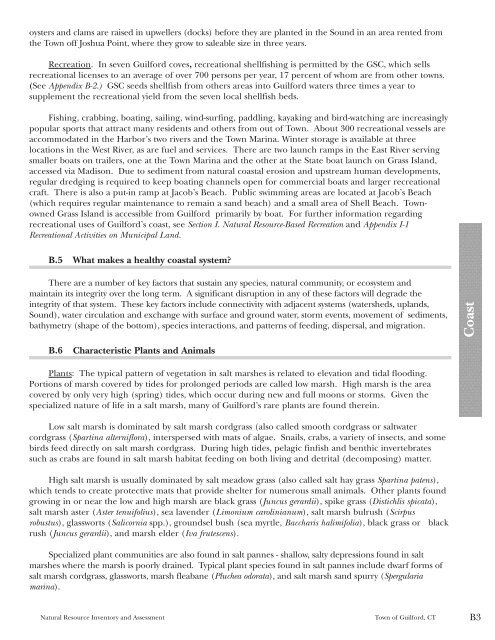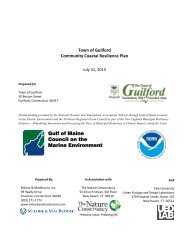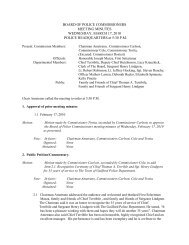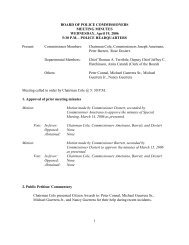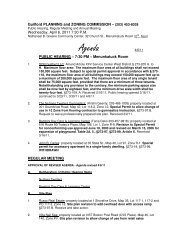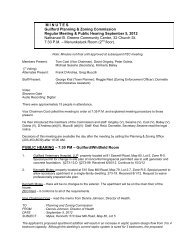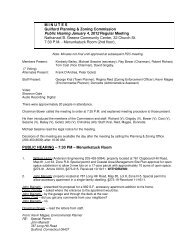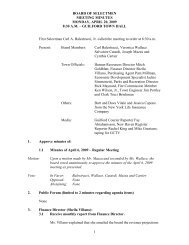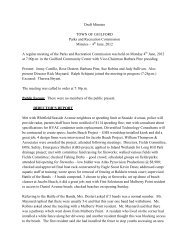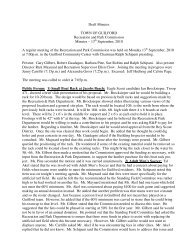Natural Resource Inventory and Assessment - Town of Guilford
Natural Resource Inventory and Assessment - Town of Guilford
Natural Resource Inventory and Assessment - Town of Guilford
Create successful ePaper yourself
Turn your PDF publications into a flip-book with our unique Google optimized e-Paper software.
oysters <strong>and</strong> clams are raised in upwellers (docks) before they are planted in the Sound in an area rented from<br />
the <strong>Town</strong> <strong>of</strong>f Joshua Point, where they grow to saleable size in three years.<br />
Recreation. In seven <strong>Guilford</strong> coves, recreational shellfishing is permitted by the GSC, which sells<br />
recreational licenses to an average <strong>of</strong> over 700 persons per year, 17 percent <strong>of</strong> whom are from other towns.<br />
(See Appendix B-2.) GSC seeds shellfish from others areas into <strong>Guilford</strong> waters three times a year to<br />
supplement the recreational yield from the seven local shellfish beds.<br />
Fishing, crabbing, boating, sailing, wind-surfing, paddling, kayaking <strong>and</strong> bird-watching are increasingly<br />
popular sports that attract many residents <strong>and</strong> others from out <strong>of</strong> <strong>Town</strong>. About 300 recreational vessels are<br />
accommodated in the Harbor’s two rivers <strong>and</strong> the <strong>Town</strong> Marina. Winter storage is available at three<br />
locations in the West River, as are fuel <strong>and</strong> services. There are two launch ramps in the East River serving<br />
smaller boats on trailers, one at the <strong>Town</strong> Marina <strong>and</strong> the other at the State boat launch on Grass Isl<strong>and</strong>,<br />
accessed via Madison. Due to sediment from natural coastal erosion <strong>and</strong> upstream human developments,<br />
regular dredging is required to keep boating channels open for commercial boats <strong>and</strong> larger recreational<br />
craft. There is also a put-in ramp at Jacob’s Beach. Public swimming areas are located at Jacob’s Beach<br />
(which requires regular maintenance to remain a s<strong>and</strong> beach) <strong>and</strong> a small area <strong>of</strong> Shell Beach. <strong>Town</strong>owned<br />
Grass Isl<strong>and</strong> is accessible from <strong>Guilford</strong> primarily by boat. For further information regarding<br />
recreational uses <strong>of</strong> <strong>Guilford</strong>’s coast, see Section I. <strong>Natural</strong> <strong>Resource</strong>-Based Recreation <strong>and</strong> Appendix I-1<br />
Recreational Activities on Municipal L<strong>and</strong>.<br />
B.5 What makes a healthy coastal system?<br />
There are a number <strong>of</strong> key factors that sustain any species, natural community, or ecosystem <strong>and</strong><br />
maintain its integrity over the long term. A significant disruption in any <strong>of</strong> these factors will degrade the<br />
integrity <strong>of</strong> that system. These key factors include connectivity with adjacent systems (watersheds, upl<strong>and</strong>s,<br />
Sound), water circulation <strong>and</strong> exchange with surface <strong>and</strong> ground water, storm events, movement <strong>of</strong> sediments,<br />
bathymetry (shape <strong>of</strong> the bottom), species interactions, <strong>and</strong> patterns <strong>of</strong> feeding, dispersal, <strong>and</strong> migration.<br />
B.6 Characteristic Plants <strong>and</strong> Animals<br />
Plants: The typical pattern <strong>of</strong> vegetation in salt marshes is related to elevation <strong>and</strong> tidal flooding.<br />
Portions <strong>of</strong> marsh covered by tides for prolonged periods are called low marsh. High marsh is the area<br />
covered by only very high (spring) tides, which occur during new <strong>and</strong> full moons or storms. Given the<br />
specialized nature <strong>of</strong> life in a salt marsh, many <strong>of</strong> <strong>Guilford</strong>’s rare plants are found therein.<br />
Low salt marsh is dominated by salt marsh cordgrass (also called smooth cordgrass or saltwater<br />
cordgrass (Spartina alterniflora), interspersed with mats <strong>of</strong> algae. Snails, crabs, a variety <strong>of</strong> insects, <strong>and</strong> some<br />
birds feed directly on salt marsh cordgrass. During high tides, pelagic finfish <strong>and</strong> benthic invertebrates<br />
such as crabs are found in salt marsh habitat feeding on both living <strong>and</strong> detrital (decomposing) matter.<br />
High salt marsh is usually dominated by salt meadow grass (also called salt hay grass Spartina patens),<br />
which tends to create protective mats that provide shelter for numerous small animals. Other plants found<br />
growing in or near the low <strong>and</strong> high marsh are black grass (Juncus gerardii), spike grass (Distichlis spicata),<br />
salt marsh aster (Aster tenuifolius), sea lavender (Limonium carolinianum), salt marsh bulrush (Scirpus<br />
robustus), glassworts (Salicornia spp.), groundsel bush (sea myrtle, Baccharis halimifolia), black grass or black<br />
rush (Juncus gerardii), <strong>and</strong> marsh elder (Iva frutescens).<br />
Specialized plant communities are also found in salt pannes - shallow, salty depressions found in salt<br />
marshes where the marsh is poorly drained. Typical plant species found in salt pannes include dwarf forms <strong>of</strong><br />
salt marsh cordgrass, glassworts, marsh fleabane (Pluchea odorata), <strong>and</strong> salt marsh s<strong>and</strong> spurry (Spergularia<br />
marina).<br />
<strong>Natural</strong> <strong>Resource</strong> <strong>Inventory</strong> <strong>and</strong> <strong>Assessment</strong> <strong>Town</strong> <strong>of</strong> <strong>Guilford</strong>, CT B3<br />
Coast


